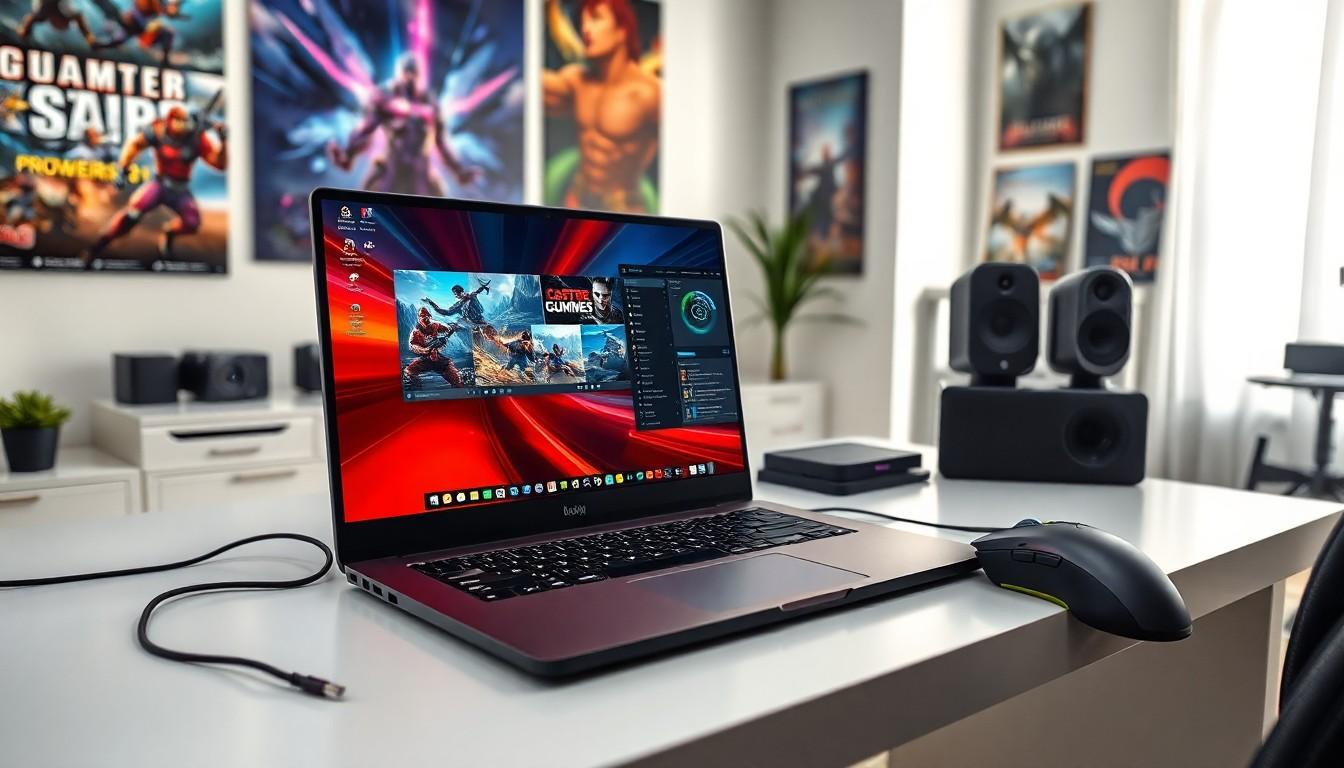For aspiring game developers, choosing the right laptop can feel like navigating a labyrinth of specs and features. With countless options promising to be the holy grail of gaming performance, it’s easy to get lost in the shuffle. But fear not! The quest for the best laptop doesn’t have to resemble a boss battle.
Best Laptop for Game Development
Game development laptops require specific features to handle demanding software. High-performance graphics cards enable smooth rendering of complex visuals. Processors with multiple cores support efficient multitasking during development.
RAM capacity matters significantly for running large applications and maintaining a seamless workflow. A minimum of 16 GB RAM is standard, though 32 GB or more is ideal for intensive tasks. Storage type also plays a crucial role; solid-state drives (SSDs) offer faster load times compared to traditional hard drives.
Screen quality impacts the development experience. Full HD (1920 x 1080) displays provide clarity for detailed graphics design. Larger screens or ultrawide monitors enhance productivity by allowing multiple applications to run simultaneously.
Portability is essential for developers who work on the go. Lightweight options with robust battery life serve well in various environments. Connectivity options, including USB-C ports and HDMI outputs, improve compatibility with external devices.
Thermal management ensures laptops remain cool during intensive tasks. Effective cooling solutions prevent overheating, extending the lifespan of the internal components.
When evaluating potential laptops, consider GPU performance benchmarks, CPU processing power, and RAM capacity. User reviews and expert analyses provide insight into real-world performance. Selecting the right laptop simplifies the game development process, enabling creativity to flourish.
Key Features To Consider
Selecting the right laptop for game development involves understanding several critical features. Each aspect plays a role in ensuring that the device effectively meets the demands of development tasks.
Processor Performance
Processor performance ranks high among the features to prioritize. Multi-core processors enhance multitasking capabilities, allowing developers to run various applications simultaneously without lag. Look for processors with a minimum of four cores, although six or more provides even better efficiency. The clock speed also matters; higher speeds contribute to quicker data processing. Popular choices include Intel Core i7 or AMD Ryzen 7 processors that excel in handling intense workloads.
Graphics Card Importance
Graphics cards influence the ability to render complex visuals. A dedicated graphics card is essential for game development, as it delivers superior performance compared to integrated graphics. Aim for GPUs with 4 GB or more of VRAM to handle demanding graphics and support modern game engines. NVIDIA and AMD offer some of the best options; models like the NVIDIA GeForce RTX 3060 stand out for their performance. Ensuring the chosen laptop has strong GPU benchmarks will significantly benefit rendering tasks.
RAM and Storage Requirements
RAM and storage requirements play a crucial role in game development. A minimum of 16 GB of RAM is recommended, while 32 GB is ideal for handling resource-intensive projects. More RAM allows for smoother performance during multitasking and running demanding applications. In terms of storage, solid-state drives (SSDs) outperform traditional hard drives with faster load times and improved overall responsiveness. Aim for at least 512 GB of SSD storage to provide ample space for projects, software, and game assets. Prioritizing these specifications ensures a seamless development experience.
Top Picks For The Best Laptop For Game Development
Three laptops stand out for their exceptional performance in game development. Each laptop offers unique specifications to cater to varying needs.
Laptop 1: Specifications and Performance
The Razer Blade 15 features a 10th-generation Intel Core i7 processor paired with an NVIDIA GeForce RTX 3060 GPU. This combination supports rendering complex visuals efficiently. It includes 16 GB of RAM, ensuring reliable multitasking during intensive tasks. Developers can also benefit from a 512 GB SSD, providing fast load times. A 15.6-inch Full HD display enhances productivity with vibrant colors and clarity. The lightweight design and strong battery life make it portable for developers on the go.
Laptop 2: Specifications and Performance
The Dell XPS 15 comes equipped with an Intel Core i7-12700H processor and NVIDIA GeForce RTX 3050 Ti graphics card. With 32 GB of RAM, this laptop excels in handling multiple applications seamlessly. It offers a spacious 1 TB SSD, enabling rapid access to projects and assets. The 15.6-inch 4K UHD display delivers stunning visuals, essential for game graphics. This model’s sleek design and impressive battery life ensure portability without compromising performance.
Laptop 3: Specifications and Performance
The ASUS ROG Zephyrus G14 sports an AMD Ryzen 9 5900HS processor along with an NVIDIA GeForce RTX 3060 GPU. Boasting 32 GB of RAM, it manages complex tasks effortlessly. A 1 TB SSD guarantees quick load times and ample storage for large game files. The 14-inch QHD display provides sharp images, enhancing the development experience, especially when using tools like an AI image generator. Moreover, its lightweight frame and robust battery life make it suitable for working on the move.ove.
Comparison Chart of Best Laptops
| Laptop Model | Processor | GPU | RAM | SSD | Screen | Weight |
|---|---|---|---|---|---|---|
| Razer Blade 15 | Intel Core i7 (10th Gen) | NVIDIA GeForce RTX 3060 | 16 GB | 512 GB | 15.6″ Full HD | 4.4 lbs |
| Dell XPS 15 | Intel Core i7-12700H | NVIDIA GeForce RTX 3050 Ti | 32 GB | 1 TB | 15.6″ 4K | 4.5 lbs |
| ASUS ROG Zephyrus G14 | AMD Ryzen 9 5900HS | NVIDIA GeForce RTX 3060 | 32 GB | 1 TB | 14″ QHD | 3.5 lbs |
The Razer Blade 15 delivers high performance with its 10th-generation Intel processor and efficient graphics capabilities. Users appreciate the portability combined with a 15.6-inch Full HD screen, making it suitable for on-the-go development.
The Dell XPS 15 stands out with its powerful Core i7-12700H processor and 4K display. Offering 32 GB of RAM and a 1 TB SSD, it caters to developers who prioritize stunning visuals and extensive storage.
The ASUS ROG Zephyrus G14 combines the AMD Ryzen 9 processor and NVIDIA graphics for an exceptional gaming experience. It features a lightweight design, making it ideal for developers requiring mobility without sacrificing performance.
Each laptop excels in crucial metrics for game development, from robust processors to dedicated GPUs. Developers should consider their specific needs when selecting a laptop, balancing performance, graphics quality, and portability.
Selecting the best laptop for game development can significantly enhance the creative process. By focusing on essential features like powerful processors high-performance graphics cards and ample RAM developers can streamline their workflow.
The right laptop not only meets technical requirements but also supports a productive and enjoyable development environment. Each of the highlighted models offers unique strengths catering to various preferences and needs.
Ultimately investing in a quality laptop empowers developers to bring their visions to life while navigating the complexities of game creation with ease.




